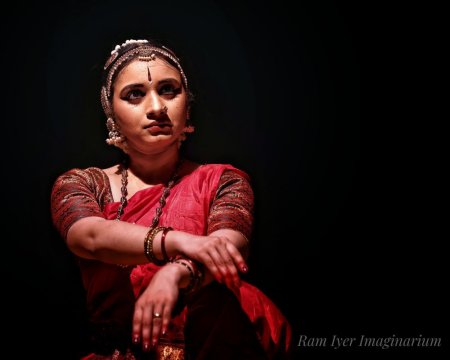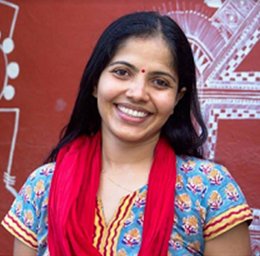
|   |

|   |
An enchanting Margam by Meera Sreenarayanan - Vinita Radhakrishnan e-mail: vinitaradhakrishnan@gmail.com Photos: Ram Iyer January 11, 2024 Ever so rarely, a person is born, whose purpose in life seems to be predestined. Meera Sreenarayanan is one such being who is born to dance. Every time I have watched her on stage, I have felt that no one celebrates dance the way she does. It almost feels as if the moment she steps on the stage she is possessed by a higher power who dictates the dance for the day, and she, with utmost humility, allows it. This year at the Madras Music Academy, Meera's performance was magical. Her performance put me in a blissful trance and it is only after two days, I mustered the courage to articulate my experience of the event. While her performance was structured as a traditional margam with a Mallari, a Varnam, a Padam, a Javali, and a Thillana, like an adept storyteller she weaved a very compelling story through them keeping the rasikas engaged and invested till the end.  The theme of the margam was an Ode to Lord Karthikeya or Muruga and she celebrated him with literally everything she had. Through her eyes, I saw a Muruga who was more handsome than he has ever been in my imagination. During her entire performance, it seemed as though Meera had her audience under a very potent spell. Neither did she leave the stage for the hour and a half she performed, nor was I able to take my eyes off her. To hold the audience in rapt attention for over an hour is no mean feat but for Meera, it seemed like a breeze. The recital started with a traditional Mallari, a musical composition of Easwar Ramakrishnan in raga Gambheera Nattai and the solukettu composed by Charudutt V.V. As Meera marked the arrival of the Lord to the beats of the Mallari, she moved through the stage with such agility, that despite it being a solo piece, one could effortlessly visualize the entire procession on stage. The inclusion of the thavil by Adyar G. Silambarasan and nadaswaram by Mylai Karthikeyan for the Mallari added to the experience by creating a ritualistic atmosphere similar to what we see at the South Indian temple processions. While the world was celebrating the arrival of the lord to the tunes of the Mallari, Meera, very gently, brought our attention to a Virahotkhandita Nayika, waiting at her doorsteps, yearning to unite with the lord as she seamlessly walked into her next piece, a Varnam "Mohalagiri meerudhe" in ragam Kapi, a composition of Kunnakudi Venkatarama Iyer and a choreography of her acharya Indira Kadambi. The Varnam is a choreographic masterpiece with swift and beautiful jathis and rich sancharis filled with exquisite metaphors. Meera's ability to seamlessly flow from one idea to the other without breaking the thread of thought was dextrous and extraordinary. My favorite part of the Varnam was the comparison of the Nayika's longing to unite with her lord to that of the waves wanting to touch the setting sun. As the sun went down the intensified passion was compared to that of the increased vigour of the tidal waves that yearn to reach the moon. While Meera used her body as an instrument to emote this idea, her command on every cell of her body was evident for she became the wave yearning for togetherness. Meera portrayed the pining Nayika so convincingly that the entire auditorium was rooting for her to unite with her love. So, in an unusual ending to the Varnam when she showed Muruga knocking at the door to enter the abode of the Nayika, suggesting a night of togetherness, the collective relief felt in the auditorium was hard to miss. After a night of passion, the Nayika was shown to be waking up to her next piece, a Malayalam Padam "Prananathan enikye nalkiya", a composition of Irayimman Thampi, set in Kambhoji ragam and choreographed by Meera herself. Through this piece the Nayika describes the passionate night with her lord. While this composition is an erotic piece of literature, Meera performed the piece with utmost sensuality without a hint of vulgarity. One has seen many acclaimed artistes struggle while treading that line, but Meera achieved it to perfection.  This was followed by a Javali "Janatanamu maatalu" in Sourashtram raga, a composition of an unknown author, where she portrayed a Khandita Nayika, upset with her lord for having united with the other woman. With a fine balance of anger, sarcasm, and humour, Meera brought to life this Nayika making all of us equally sympathize with her as well. The Javali was followed by a Thillana in raga Simhendramadhyama, a choreography of Guru C.V. Chandrasekhar. As a prelude to the Thillana, Meera depicted a Bhakta ready for Kavadi Attam, bravely poking the 'Vel' (the long needle) through her tongue as one very prominent tear trickled down her eye. I can still feel the chill in my spine as I remember that moment on stage. Meera's margam was filled with such carefully spaced unnervingly real moments. Her vocalist Bijeesh Krishna deserves a special mention for bringing Muruga to life on stage with his music as she did with her dance. The music ensemble with Bijeesh Krishna on vocal, Indira Kadambi on nattuvangam, Kalamandalam Charudutt on mridangam, N. Anantha Narayanan on veena, and Easwar Ramakrishnan on violin worked together like a well-oiled machine, dextrously creating this magical experience on stage.  Bangalore based Bharatanatyam dancer Vinita Radhakrishnan has a Diploma from the Attakkalari Center for Movement Art with basic training in various contemporary dance techniques, Ballet, Kalari, Chhau and Deverattom. Professionally, she is a Patent Attorney and is currently working as a Senior Partner at BananaIP Counsels. |